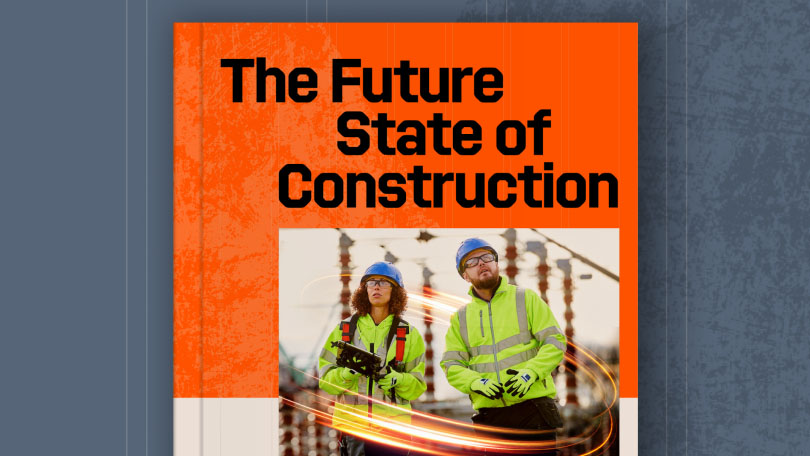— 10 min read
Construction Cash Flow: Making or Breaking Projects


Last Updated Aug 28, 2025

Nicholas Dunbar
Content Manager
62 articles
Nick Dunbar oversees the creation and management of UK and Ireland educational content at Procore. Previously, he worked as a sustainability writer at the Building Research Establishment and served as a sustainability consultant within the built environment sector. Nick holds degrees in industrial sustainability and environmental sciences and lives in Camden, London.

Zoe Mullan
27 articles
Zoe Mullan is an experienced content writer and editor with a background in marketing and communications in the e-learning sector. Zoe holds an MA in English Literature and History from the University of Glasgow and a PGDip in Journalism from the University of Strathclyde and lives in Northern Ireland.
Last Updated Aug 28, 2025

Cash flow is one of the most critical – and fragile – aspects of running a construction business. Projects often appear profitable on paper, yet leave companies struggling to pay bills, wages, or suppliers on time. This paradox occurs because construction cash flow operates as a complex numbers game that juggles factors like timing, forecasting, and operational continuity.
Given its high upfront costs and intricate subcontractor networks, the construction industry faces particular vulnerability when companies fail to manage cash flow effectively. Understanding construction cash flow – what it involves, how to control it, and which strategies work – enables companies to run projects smoothly while maintaining competitive advantage.
Table of contents
Defining Construction Cash Flow
Cash flow tracks how money moves in and out of a business. In construction, this flow becomes particularly volatile due to long timelines, phased payments, and complex supply chains that define most projects.
Construction cash flow involves balancing incoming payments – such as deposits, progress payments, and retentions – against outgoing costs, including materials, labour, equipment, and overheads. Unlike profit, which companies typically assess after project completion, cash flow concerns the availability of funds at each stage of the project lifecycle.
Maintaining healthy cash flow helps companies meet their financial obligations as they arise, avoiding delays, penalties, or damaged supplier relationships. Even profitable firms can face cash flow problems if payments arrive late or costs escalate unexpectedly. Therefore, construction cash flow becomes an operational priority that underpins a company's ability to deliver projects on time and within budget.
Core Components of Cash Flow Management
Successfully managing construction cash flow begins with understanding its fundamental elements. These break down into inflows, outflows, and forecasting tools that maintain visibility and control.
Managing Incoming Cash (Inflows)
Cash inflows encompass all money that construction companies receive during a project. This typically includes:
- Client payments for completed work, usually made in stages
- Deposits or advance payments at project initiation
- Retentions, which are withheld sums released upon project completion or following a defects liability period
Controlling Outgoing Cash (Outflows)
Cash outflows cover all costs incurred to keep projects moving. These often include:
- Materials and equipment
- Labour costs, including subcontractor payments
- Permits, insurance, and compliance fees
- Overheads, such as office expenses, transport, and utilities
Since many of these costs arise before companies receive payments, businesses can quickly face shortfalls without proactive cash flow planning.
Implementing Cash Flow Forecasting
Forecasting involves predicting future inflows and outflows based on project timelines, payment schedules, and expected expenses. This practice helps identify potential shortfalls in advance so companies can factor them into their planning. Tools such as digital cash flow trackers, construction accounting software, and integrated project management platforms enhance forecasting accuracy by providing real-time visibility across all financial aspects of a project.
Utilising S-Curve Modelling
An S-curve provides a visual tool for mapping cumulative costs or work progress over time. It reflects the typical lifecycle of a construction project – slow at first, accelerating through the middle, then tapering off towards completion. This model helps to make forecasting more accurate by aligning financial data with project milestones.
Why Cash Flow Matters in Construction
Beyond serving as a financial metric, cash flow in construction reflects a company's operational health and ability to deliver projects without disruption. Managing it effectively helps firms stay resilient in the face of construction work's unpredictable nature. Effective cash flow management makes a difference in four key areas:
Ensuring Project Completion
Companies must maintain sufficient working capital to fund materials, labour, equipment hire, and subcontractor fees. If cash runs dry mid-project, work may grind to a halt, resulting in delays, penalties, and reputational damage.
Maintaining Financial Stability
Irregular or negative cash flow can lead to missed payments, strained supplier relationships, and difficulties in securing credit or insurance. Maintaining stability leads to smoother operations and helps preserve a contractor's reputation in a competitive market.
Protecting Profitability
Cash flow directly impacts profitability. When funds remain available, companies reduce their need for costly short-term borrowing, while strong forecasting prevents over-ordering and allows companies to capitalise on discounts or favourable terms.
Enabling Growth and Expansion
Strong cash positions enable companies to invest in new equipment, bid on larger contracts, or recruit additional staff when needed. Growth requires capital, and this capital typically comes from consistent, well-managed cash flow rather than profit alone.
Common Cash Flow Challenges
The construction industry's nature – with its long payment cycles, unpredictable changes, and upfront costs – means even established construction firms can face cash flow difficulties. Several recurring obstacles can quickly pressure finances:
Dealing with Delayed Payments
Late payments are one of the most persistent issues in construction. When clients or key contractors delay invoice payments, this creates a domino effect that disrupts payments to subcontractors and suppliers. This can affect project delivery and pressure long-term business relationships. While legislation such as the Construction Act gives contractors the right to regular interim payments and establishes deadlines for payment, enforcement can prove slow and complex. In practice, delayed cash inflows remain a widespread challenge.
Managing Significant Upfront Costs
Construction projects often require considerable investment before companies receive any payment. Materials, permits, equipment hire, and early-stage labour costs must all be covered in advance, placing strain on working capital if not planned for properly.
Handling Unplanned Change Orders
Scope changes occur commonly on construction sites, but they often come without a clear plan for funding additional work. Without prompt agreement on revised budgets and payment terms, change orders can erode margins and tie up cash unexpectedly.
Avoiding Excess Inventory
Ordering too much stock or holding materials on site longer than needed requires cash that could be used elsewhere. While securing supplies early can avoid delays, poor inventory management can reduce liquidity and inflate storage or security costs.
Strategies for Improving Construction Cash Flow
Cash flow requires continuous oversight and care throughout construction projects. Companies can adopt several strategies to improve their financial management:
Enhance Cash Flow Forecasting
Develop accurate forecasts by predicting expected inflows and outflows over the project lifecycle. This forecasting should ideally incorporate known payment schedules, any anticipated delays, and seasonal trends. Using visual models like S-curves can help highlight periods of high expenditure or potential cash gaps, enabling better planning and resource allocation.
Issue Invoices Promptly
Delays in issuing invoices can stall payments by weeks or even months. Establish clear processes for submitting payment applications and ensure they comply with construction contract requirements. Follow up consistently on overdue payments and document all communication to support subsequent escalation, if necessary.
Negotiate Fair Payment Terms
Where possible, negotiate payment terms that reflect the actual pace of work more closely. This might involve requesting more frequent valuations, deposits to cover early costs, or shorter payment windows. Early engagement with clients and subcontractors can often make these adjustments easier to negotiate.
Monitor Costs at Every Stage
Track expenditure closely and compare actual costs against estimates. Implement site-level reporting to detect overspending early and avoid over-ordering materials unless absolutely necessary. Simple measures like batching deliveries or hiring equipment only when needed can improve day-to-day liquidity.
Manage Change Orders Accurately
Ensure all variations receive formal approval and pricing before work begins. Clear documentation and communication help to prevent disputes, while early agreement on revised payment terms guarantees that additional work won't drain available funds.
Secure Flexible Financing Options
In some cases, bridging short-term cash gaps through a flexible line of credit or construction-specific financing may be appropriate. The key lies in using finance as a strategic tool – not a crutch – and only where the forecast justifies repayment.
Utilise Technology for Greater Visibility
Construction management software can offer real-time insights into job costs, payment status, and budget forecasts, helping teams make faster, data-driven decisions. By integrating financial data across departments, companies can spot issues early and adapt quickly.
The Power of Forecasting and S-Curve Modelling
In a sector where payment cycles rarely align with project costs, forecasting becomes one of the most effective tools construction companies can use to maintain cash flow stability. It shows when money will arrive and when expenses will occur, helping companies prepare for financial challenges before they arise.
Why Forecasting Matters
Cash flow forecasting helps companies anticipate shortages and recognise opportunities. With an accurate forecast, companies can:
- Plan resourcing and procurement with confidence
- Avoid overreliance on short-term borrowing
- Make informed decisions about taking on new work
- Strengthen relationships with clients and subcontractors through better communication
For contractors operating under tight margins and rigorous project timelines, even a modest delay in payment can cause widespread disruption. Forecasting enables teams to act early.
Using S-Curve Modelling
S-curve modelling complements forecasting by mapping cumulative expenditure or revenue against time, helping to:
- Identify when costs are likely to spike
- Compare actual progress against planned progress
- Align payment milestones with real project needs
- Support discussions with clients or lenders using clear visual data
Combined with regular forecasting updates, S-curve modelling gives construction companies a robust way to manage uncertainty and align cash flow with project realities.
Project-Specific Cash Flow Example
A typical example of cash flow progression occurs in a mid-sized residential build with a 10-month programme. In this scenario, the contractor receives a 10% mobilisation deposit at contract award, followed by staged payments at monthly intervals, based on certified progress:
Months 1–2: Front-Loaded Costs
Site setup, groundworks, permits, and initial material purchases lead to high outflows before the first payment application receives approval. During this period, the company must rely on reserves or financing to maintain progress.
Months 3–7: Peak Activity and Balancing Inflows
Labour, subcontractor, and material costs increase as work accelerates. Monthly interim payments begin to arrive but may lag behind costs incurred on site. Careful forecasting enables the contractor to manage this cash flow gap.
Months 8–9: Tapering Off
As the build nears completion, costs begin to slow. However, retentions may start to accumulate, meaning part of the invoiced value remains held back until project sign-off, potentially delaying final inflows.
Month 10+: Final Payment and Retention Release
Once the snagging list is closed out and practical completion confirmed, the contractor receives the final payment and eventually the retention, completing the cash cycle.
This example illustrates how sporadic and delayed cash flow can be, even on a well-managed job. Without strong forecasting and cash management, cash shortfalls become almost inevitable.
Technology and Cash Flow Management
Technology is transforming how construction firms manage their finances. With real-time dashboards and AI-driven forecasting tools, digital solutions help companies identify problems earlier and make better decisions. Key impacts include:
Predictive Analytics and Risk Detection
AI tools can analyse data across multiple completed projects to predict cash flow risks before they escalate. By identifying patterns like consistent delays in payments from certain clients or underperforming phases of work, companies can take preemptive action to protect their cash position.
Smarter Forecasting
Machine-learning models are increasingly used to enhance cash flow forecasts, adjusting for real-world variables like weather delays, material price changes, or evolving payment behaviours. They become more accurate over time, reducing reliance on static spreadsheets or manual updates.
Real-Time Financial Visibility
Digital platforms now enable contractors to track income, expenses, and commitments across all active projects in real time, making decision-making easier, whether adjusting expenses or negotiating payment terms.
Automated Alerts and Workflows
AI-powered systems can issue alerts when cash thresholds are exceeded, payment deadlines missed, or variances found in the budget. By automating these controls, construction companies can reduce human error and maintain tighter oversight of their financial health.
However, while technology can greatly improve visibility and forecasting, it cannot substitute for sound judgement and proactive management. AI tools rely on quality data, and poor inputs can still lead to flawed outputs. Human oversight remains essential, particularly when dealing with client-specific payment behaviours, legal nuances, or complex contractual arrangements. Technology should enhance, not replace, financial decision-making.
Key Takeaways
Managing cash flow in construction requires both sound accounting practices and strategic thinking that impacts project delivery, financial stability, and long-term growth. Construction companies can gain greater control over their finances by understanding the flow of income and expenditure and using forecasting tools like S-curves. With the added support of technology and data-driven insights, companies are now better equipped than ever to manage risk and maintain momentum, even in uncertain conditions.
Categories:
Financial Management, Preconstruction, Project Management, Tech and Data
Written by

Nicholas Dunbar
Content Manager | Procore
62 articles
Nick Dunbar oversees the creation and management of UK and Ireland educational content at Procore. Previously, he worked as a sustainability writer at the Building Research Establishment and served as a sustainability consultant within the built environment sector. Nick holds degrees in industrial sustainability and environmental sciences and lives in Camden, London.
View profile
Zoe Mullan
27 articles
Zoe Mullan is an experienced content writer and editor with a background in marketing and communications in the e-learning sector. Zoe holds an MA in English Literature and History from the University of Glasgow and a PGDip in Journalism from the University of Strathclyde and lives in Northern Ireland.
View profileExplore more helpful resources

Construction Management Contracts: A Complete UK Guide
Managing construction contracts can lead to an extensive physical paper trail. Sharing contracts, getting signatures and managing timelines is difficult when teams and clients are scattered across job sites and...

Key Differences Between Contractors & Subcontractors
In UK commercial construction, main (or principal) contractors engage directly with project owners to deliver complete construction programmes, while subcontractors perform specific scopes of work under the main contractor’s management....

The Role of RFPs in UK Construction Projects
Requests for Proposals (RFPs) are a core document for construction procurement in the United Kingdom. Effective RFPs align expectations, establish clear evaluation criteria, and create accountability between clients and contractors....

Financial Management in Construction Projects
Effective financial management can make or break construction projects. Teams that master budgeting, cash flow and cost control are better positioned to deliver projects on time, within budget and with...
